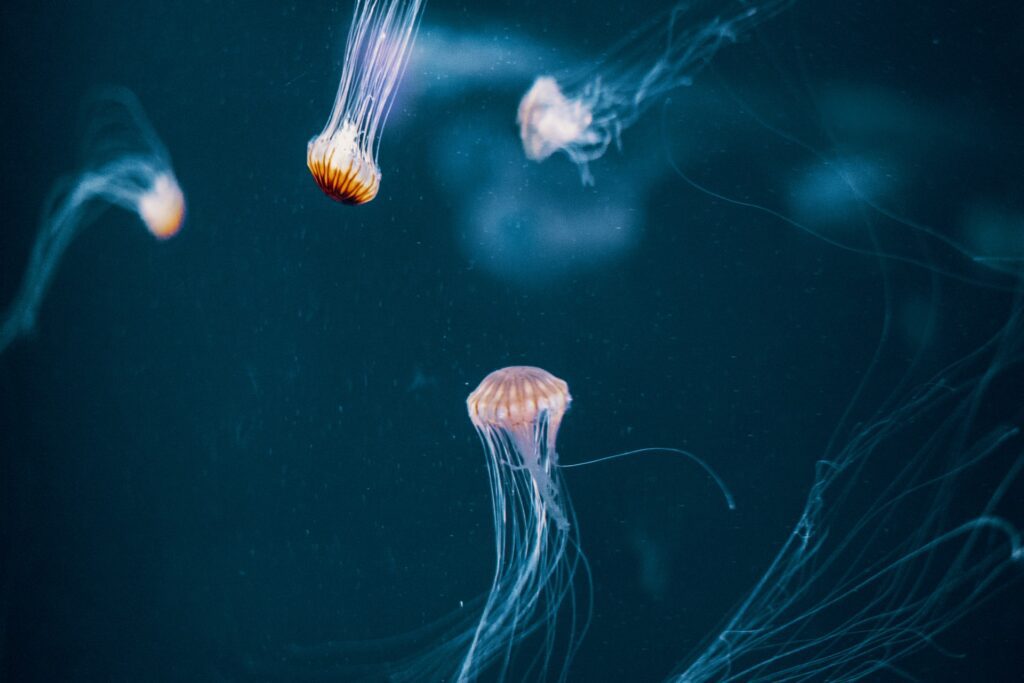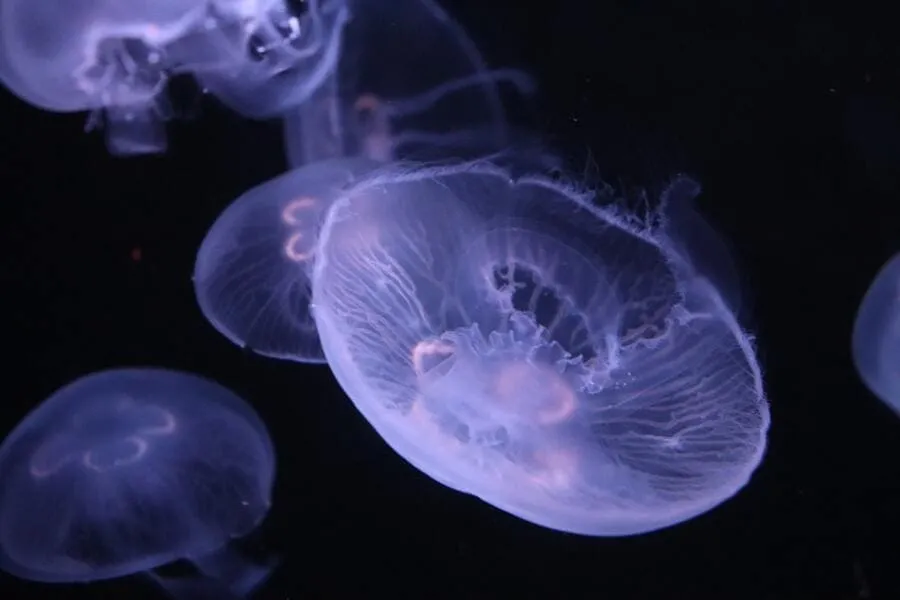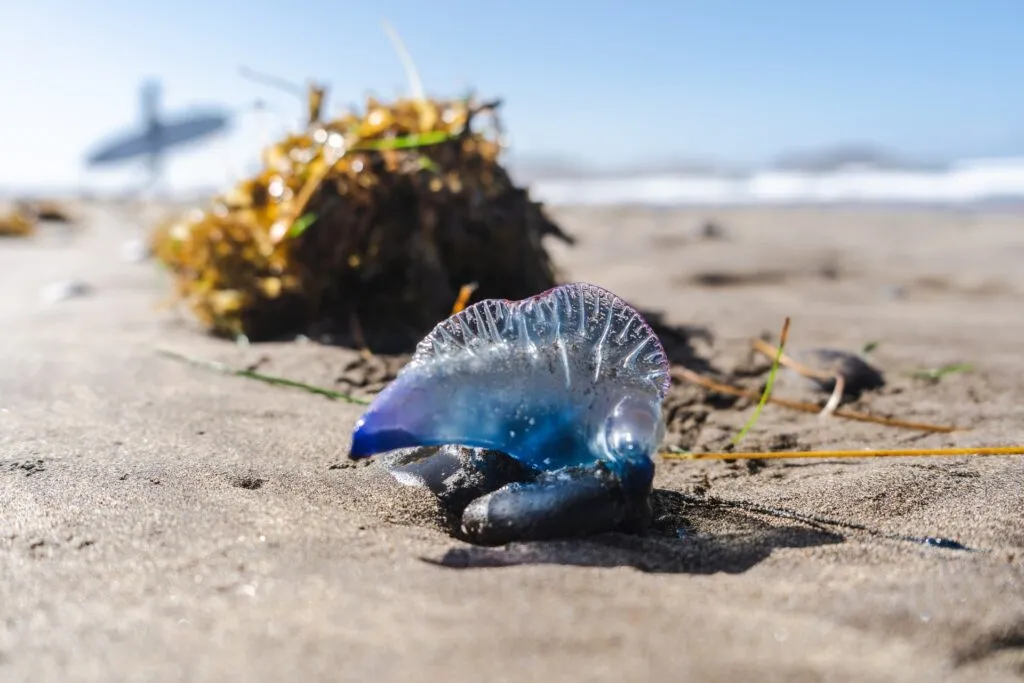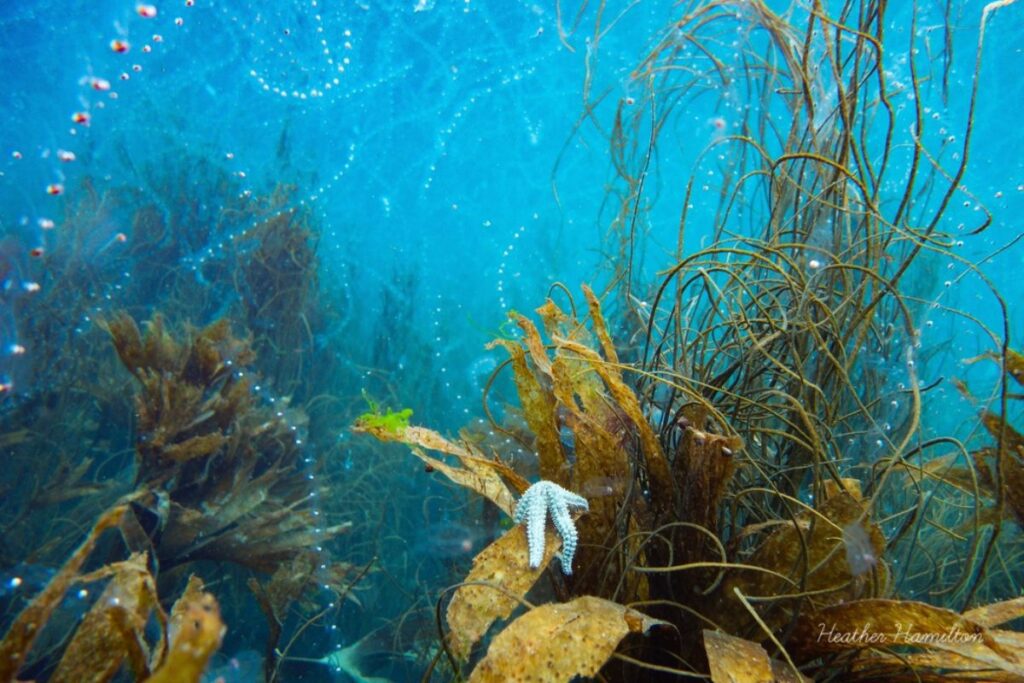The populations of many jellyfish species have grown rapidly in the last two decades, and we’re spotting more jellyfish in UK waters. If you’re a regular in the sea or visiting Cornwall, it’s important to be aware of the different jellyfish species and how to treat a jellyfish sting. We’ll also answer that age-old question, does pee help a jellyfish sting?

What are jellyfish?
Despite the name, jellyfish are not fish. Fish are defined by their vertebrae (internal backbone), among other things, whereas jellyfish have no bones. Jellyfish are actually plankton, and belong to the Cnidarian family alongside corals, anemones and sea pens.
This may come as a surprise since society tends to assume jellyfish are more sentient than sea life such as corals. In reality, jellyfish have no brain and consist of more than 90% water.
A jellyfish’s nervous system is sensitive to light, chemicals, temperature, vibrations, and senses gravity, all of which allows them to navigate and recognise danger. Their luminescence, changing colours and flowing but dangerous tentacles continue to intrigue us.
Are there jellyfish in the UK?
When it comes to types of jellyfish in the UK, we’re home to a fair few native species, as well as jellyfish that visit us from further afield;
- Moon Jellyfish
- Compass Jellyfish
- Lion’s Mane Jellyfish
- Blue Jellyfish
- Barrel Jellyfish
- Mauve Stinger Jellyfish
- Portuguese Man o’War Jellyfish
To find out more about jellyfish in our beautiful county of Cornwall specifically, check out our blog. You’ll see which of Cornwall’s jellyfish we come across on our Padstow Sealife Safaris.

Can UK jellyfish sting?
So can jellyfish in the UK sting? Yes, but some stings are barely noticeable, and others can leave you with painful welts and scarring. Luckily it’s not a guessing game and we know exactly which jellyfish are best avoided and reported. Below are just a few of the jellyfish species in the UK that sting.
Common all over the UK, Moon jellyfish are identifiable thanks to four pink rings within their transparent body mass, which takes on the colour of whatever it’s just eaten. The Moon jellyfish sting is very mild, and may cause a small rash or reddening of the skin.
Another common jellyfish in the UK and especially Cornwall is the Barrel jellyfish, and these are some of the largest we see here. They weigh up to 30kg but are a lot less scary than they look. Often their sting isn’t even felt, but if you have sensitive skin, you might notice it slightly.
The Compass jellyfish is a yellow/white and brown jellyfish with lines extending from the centre and v-shaped markings around the circular rim, looking just like a compass. This distinctive pattern is helpful because you want to avoid a compass jellyfish sting. They have a nasty sting, and even leave a tentacle behind to continue stinging – impressive but brutal!
The Lion’s Mane jellyfish is again aptly named, at up to a huge 2 metres diameter, they have a reddish/brown body and a shaggy mane of hair-like tentacles. The bad news is the Lion’s Mane jellyfish stings are very painful, the good news is they tend to be seen in the North Sea, although they are occasionally spotted in Cornwall. But now you know what to look out for, you’ll keep your distance.
Portuguese Man-O’War are perhaps the most infamous, and one of the most venomous jellyfish we see, with the worst jellyfish sting. Native to warmer waters, it’s rare to spot them in the UK but they do appear. They look like a purple plastic bag or balloon, with blue ribbons for tentacles. Their stings leave painful swelling, welts and rashes, which can last from hours to weeks, in rare cases they can be deadly.
The Marine Conservation Society is also doing a brilliant job at tracking jellyfish species in UK waters allowing them to determine wider marine life distribution trends. You can learn about more species of jellyfish found in the UK here, and read about the Marine Conservation Society, a cause especially close to our hearts. Our Sealife Safaris encourage you to experience the wonders of the ocean without having any impact on its residents or waters.
How do Jellyfish sting?
A jellyfish’s tentacles hold a vast amount of cnidocytes, or ‘stinging cells’. Once impact is felt, the cell opens immediately letting water in and in turn shooting a needle like stinger out. It then releases the venom, which shocks, stuns or paralyzes the prey.
Bear in mind that as jellyfish have no brains and rely on a complex nervous system, this whole process is based on automatic reflexes from contact. Different species of jellyfish have differing venom, which is why jellyfish stings can go from being not even noticeable to life threatening.
Found in the venom of all jellyfish is ‘porin’, a protein which acts fast to break down all types of cells. However, varied compositions of porin combined with varied stinging mechanisms in different species is the reason for each species of jellyfish having stings of varying impact.

How do you know if a jellyfish stings you?
So what does a jellyfish sting look like? The mildest stings aren’t noticeable at all – happy days. Others are more inconvenient, and once venom has been injected will cause pain, itchiness, redness and blistering.
You might see raised welts and a ‘print’ of red or purple lines that indicate the tentacle’s points of contact on your skin. The more serious stings cause nausea, dizziness, vomiting, and difficulty breathing and can be deadly.
One of the most deadly jellyfish is the Box jellyfish, often found in warmer waters, particularly in the Indo Pacific and northern Australia. A Box jellyfish sting is vicious because its venom can cause Irukandji syndrome, a deadly flood of stress hormones and inflammation proteins. Alongside the pain and nausea, it can result in a brain haemorrhage due to high blood pressure. Most of those stung by box jellyfish die within minutes from heart attacks.
How can I avoid being stung by a jellyfish?
Don’t let the very rare chance of bumping into the deadly Box jellyfish stop you having fun in the sea. Jellyfish in the UK and Cornwall tend not to be deadly, and there are plenty of things to do to protect you against jellyfish.
Wearing a wetsuit in the water is great as it puts a physical barrier between your skin and the jellyfish. Check the news before you swim, often blooms (large numbers of jellyfish) or sighted rare species are reported and you’ll know which swimming spots to avoid.
Jellyfish float with the current, so swimming against the current means you’ll be more likely to encounter them. Although it might be tempting, don’t touch washed up jellyfish on the beach, they can still sting you just as fiercely.
How do you treat a jellyfish sting?
Remember that jellyfish stingers remain in your skin after the initial sting. So don’t touch the area with bare hands from the outset, and make sure you or the person helping you wears gloves. Most stings can be treated by rinsing the skin with seawater. Whilst your instinct might be to clean the area with freshwater this makes it much worse, as it triggers the stingers and releases further venom.
Using tweezers, or even a credit card, to remove the remaining stingers will help. An effective jellyfish sting treatment is to soak the area in very warm water, as hot as can be tolerated, for at least 30 minutes. This breaks down the jellyfish toxins. Painkillers can help you bear the initial intense pain.
Do not use vinegar or ice to ease the pain, as they will hinder instead of help. Additionally, don’t rub the wound, as you’ll just be spreading the venom and toxins further. And crucially, do not pee on the sting! Peeing on a jellyfish sting is a popular myth that has no scientific basis, and studies have found it makes no difference, and if anything is unhygienic on an open wound.
This myth is thought to originate from the fact that urine contains ammonia, which could neutralize the sting, but this is heavily diluted with water and of no use. Take our word for it!
How long does a jellyfish sting last?
The intense pain of a jellyfish sting can last 1-2 hours, but the area can remain itchy and marked with raised welts for a few weeks. A jellyfish sting scar can occur in particularly severe cases, in the form of red, brown or purple lines from the points of contact. After consulting medical advice, keep these clean with antiseptic, moisturize regularly and keep out of the sun to prevent them darkening. Extreme jellyfish sting scars treatment is laser therapy in rare cases.

How painful is a jellyfish sting?
Jellyfish stings are painful, but in mild cases can be compared to that of a wasp sting – intensely painful for a short burst of time with no adverse long term side effects. In more serious cases, the pain is severe and causes illness that needs urgent medical attention.
Always alert the lifeguard and people you’re with if you’ve been stung by jellyfish and pay attention to your symptoms. Just like wasp or bee stings, it is possible to have an allergic reaction to jellyfish stings, so be mindful of this too.
When should I be concerned about a jellyfish sting?
Localised small reactions in the area of the sting aren’t a cause for panic. They might be painful, itchy and unsightly but follow the advice of lifeguards and the NHS and you’ll be right as rain. The NHS recommends visiting a minor injuries unit if you have severe pain that isn’t going away or has been stung on your face or genitals.
The NHS advises visiting A&E or calling 999 if you’ve been stung and have difficulty breathing, chest pain, seizures, severe swelling, severe bleeding, vomiting, light-headedness or loss of consciousness. Jellyfish symptoms can escalate quickly, so it’s better to be safe than sorry. See the NHS advice here.
Jellyfish are impressive prehistoric creatures unlike anything else, spotting a bloom of Cornish jellyfish on our Sea Life Safaris always delights us! As with all marine life, they deserve our respect and awareness.
On the whole jellyfish stings are unpleasant, but no more than that. The chances of coming across deadly jellyfish are incredibly slim, but it’s always good to know what you might come across in the sea. And remember, don’t pee on your jellyfish sting!
Sources
- https://www.businessinsider.com/jellyfish-thriving-climate-change-warm-oceans-2019-10?r=US&IR=T
- https://www.oneearth.org/five-jaw-dropping-facts-about-jellyfish/
- https://www.mcsuk.org/news/jellyfish-superstars-you-can-spot-uk-shores/
- https://www.healthline.com/health/jellyfish-sting
- https://www.nhs.uk/conditions/jellyfish-and-other-sea-creature-stings/


